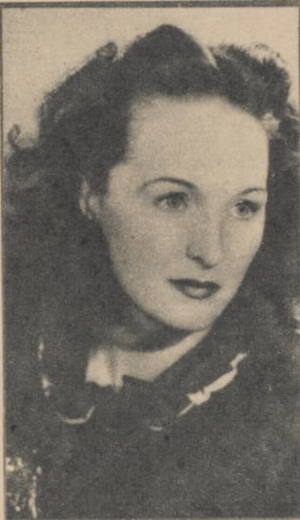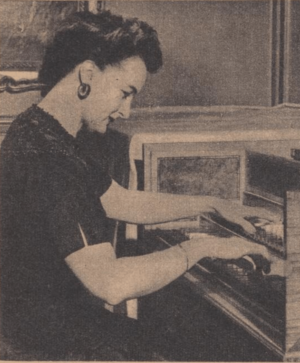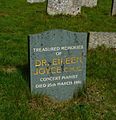Eileen Joyce facts for kids
Quick facts for kids
Eileen Joyce
|
|
|---|---|

Eileen Joyce in 1952
|
|
| Born |
Eileen Alannah Joyce
21 November 1907 or 1 January 1908 |
| Died | 25 March 1991 (aged 83) Redhill, Surrey, England
|
| Musical career | |
| Instruments | Piano, harpsichord |
Eileen Alannah Joyce was an amazing Australian pianist. She became famous for her music career, which lasted over 30 years. She spent most of her adult life living in England.
Her recordings became very popular in the 1930s and 1940s, especially during World War II. People loved her music so much that she was compared to famous stars like Gracie Fields and Vera Lynn. A German critic even said she was as good as legendary pianists like Clara Schumann.
Eileen Joyce became even more well-known in the 1950s. She played about 50 concerts a year in London, and every single one was sold out! She also performed special "Marathon Concerts" where she played up to four piano concertos in one night. Her playing was praised for being beautiful and powerful.
You might have heard her music without knowing it! She played the piano for the famous second movement of Rachmaninoff's 2nd Piano Concerto in the movies Brief Encounter and The Seventh Veil (both from 1945). This helped make the music very popular. A book about her early life came out in 1950 and became a bestseller. A movie called Wherever She Goes (1951) was based on the book.
Even though she was very famous, her name wasn't as well-known after she retired in the early 1960s. Luckily, her recordings have been re-released on CDs, so new generations can enjoy her incredible talent.
Contents
Eileen Joyce's Early Life and Music Education
Eileen Joyce was born in Zeehan, a mining town in Tasmania, Australia. She was born on January 1, 1908, though she often said her birthday was November 21 in a later year. She was one of seven children in her family.
Her family later moved to Western Australia, living in places like Kununoppin and Boulder. Even though they weren't rich, her parents encouraged her love for music. She started piano lessons when she was 10 years old.
Discovering a Young Genius
Eileen went to St Joseph's Convent School in Boulder, where Sister Mary Monica Butler taught her music. When Eileen was 13, she had to leave school because of her family's money problems. However, they found a way for her to continue piano lessons with a private teacher named Rosetta Spriggs.
Rosetta Spriggs introduced Eileen to Charles Schilsky, a music examiner visiting from Trinity College. Schilsky was amazed by Eileen's talent. He wrote that her playing was pure "genius" and the greatest he had ever heard.
Schilsky helped Eileen go to Loreto Convent in Claremont, Perth, to continue her studies. Her new music teacher there was Sister John More. Eileen won the Grand Championship at the Perth Eisteddfods in both 1925 and 1926. Schilsky kept telling people about her talent, even writing to newspapers to suggest she should study music in Paris.
Support for a Rising Star
In May 1926, the Premier of Western Australia, Philip Collier, started an "Eileen Joyce Fund." The goal was to raise £1,000 to help her music career. In August 1926, the famous musician Percy Grainger met Eileen and heard her play.
Grainger was incredibly impressed. He wrote an open letter saying Eileen Joyce was the most talented young piano student he had heard in 25 years. He believed she would become as famous as other great pianists. He suggested she study with an Australian master to keep her unique playing style.
Soon after, another famous pianist, Wilhelm Backhaus, heard Eileen play. He suggested she go to the Leipzig Conservatorium in Germany, which was a top music school at the time.
Studying in Europe
From 1927 to 1929, Eileen studied at the Leipzig Conservatorium. She learned from teachers like Robert Teichmüller and explored many different pieces of music. After Leipzig, she went to the Royal College of Music in London. With help from the famous pianist Myra Hess, she studied under Tobias Matthay.
Eileen Joyce's Amazing Music Career
Eileen Joyce made her first professional performance in London on September 6, 1930. She played Prokofiev's Piano Concerto No. 3 at a Henry Wood Promenade Concert. Her first solo concert in England was on March 23, 1931. She started making recordings in 1933, which helped her become widely known.
A Popular Performer
Eileen became a regular performer for the BBC and was in high demand for concerts across Britain. She was the first pianist to play Shostakovich's piano concertos in Britain. She performed the First Piano Concerto in 1936 and the Second in 1958.
During World War II, Eileen played many concerts, especially in areas that had been bombed. She often performed with conductor Sir Malcolm Sargent and the London Philharmonic Orchestra. She also appeared at the National Gallery concerts organized by Dame Myra Hess.
Eileen Joyce was known for her striking beauty and unique style. She would change her evening gowns to match the music she was playing. For example, she wore blue for Beethoven and red for Tchaikovsky! She even styled her hair differently for each composer. These glamorous outfits, some designed by Norman Hartnell, made her concerts even more exciting.
Vast Repertoire and Favorite Concertos
Eileen had a huge collection of music she could play, including over 70 concertos. Some of these were unusual pieces like the Piano Concerto in E-flat major by John Ireland. She made the first recording of the Ireland concerto in 1940.
However, three concertos were her absolute favorites and she played them more than any others: the Grieg Piano Concerto in A minor, the Tchaikovsky Piano Concerto No. 1, and especially the Rachmaninoff Piano Concerto No. 2.
She performed with all the major orchestras in the UK and many around the world. She toured Australia in 1936 and 1948. In 1947, she was the first British artist in over a decade to perform with the famous Berlin Philharmonic Orchestra.
International Tours and "Marathon Concerts"
Eileen Joyce finally toured the United States in 1950, playing in Philadelphia and Carnegie Hall in New York. While her concerts in Philadelphia received great reviews, the New York critics were less impressed. She never became very popular in the U.S. and didn't return.
She toured many other countries, including New Zealand, France, the Netherlands, Germany, Italy, Belgium, South Africa, Norway, Sweden, Yugoslavia, Brazil, Argentina, Finland, Spain, Portugal, the Soviet Union, Denmark, India, and Hong Kong.
In the late 1940s and early 1950s, Eileen became famous for her "Marathon Concerts." In these special evenings, she would play up to four concertos! For example, in 1951, she played concertos by Haydn, Tchaikovsky, John Ireland, and Grieg in one concert at the Royal Albert Hall.
Eileen also developed an interest in the harpsichord, an older keyboard instrument. She gave harpsichord concerts and even performed with other harpsichordists in concerts featuring four harpsichords.
Retirement and Later Appearances
In 1960, during her tour of India, Eileen announced her retirement. Her final major concert was in Stirling, Scotland, on May 18, 1960. She played pieces by many famous composers like Scarlatti, Beethoven, Mendelssohn, Debussy, Chopin, Ravel, Granados, and Liszt.
She did return to the stage a few times over the next 21 years. In 1967, she played Rachmaninoff's Piano Concerto No. 2 with the Royal Philharmonic Orchestra, which was her last concerto performance. She also performed with other harpsichordists and in two-piano recitals. Her very last performance as a pianist was in 1981.
In August 1981, Eileen Joyce was a judge for the 2nd Sydney International Piano Competition. She also helped with the competition in 1985 and 1988.
Eileen Joyce passed away on March 25, 1991, at the age of 83. She was cremated, and her ashes were buried at St Peter's Anglican Church in Limpsfield, England.
Famous Conductors Eileen Joyce Worked With
Eileen Joyce performed with many of the world's greatest conductors. Some of these included Sir John Barbirolli, Sir Thomas Beecham, Sir Adrian Boult, Herbert von Karajan, Eugene Ormandy, and Sir Malcolm Sargent.
In an interview in 1969, she said that Sergiu Celibidache was the greatest conductor she ever worked with. She felt he truly understood her music.
Eileen Joyce in Films
Eileen Joyce's piano playing was featured in several films, making her music even more widely known.
She is most famous for playing the piano for Rachmaninoff's Piano Concerto No. 2 in the classic 1945 film Brief Encounter. This music became very popular because of the movie.
She also provided the piano music for the 1945 film The Seventh Veil. This film also featured Rachmaninoff's 2nd Concerto, as well as Grieg's Piano Concerto and solo pieces by Mozart, Chopin, and Beethoven.
Eileen appeared as herself in Battle for Music (1945), a film about the struggles of the London Philharmonic Orchestra during the war. She also played a part of Franck's Symphonic Variations in the 1946 British film A Girl in a Million. Her playing of Schubert's Impromptu in E-flat was heard in the 1947 film Quartet. She also appeared as herself in Trent's Last Case (1952), playing a Mozart concerto.
A book about her early life, Prelude: The Early Life of Eileen Joyce, was published in 1950 and became a bestseller. It was translated into many languages and even into Braille. A black-and-white film based on the book, Wherever She Goes, was made in 1951. Eileen Joyce herself briefly appeared at the beginning and end of the film, playing the Grieg concerto.
Honours and Recognition for Eileen Joyce
Eileen Joyce received many important awards and recognitions for her contributions to music.
In 1971, she was given an honorary Doctorate of Music by the University of Cambridge. She was very proud of this and liked to be called "Doctor Joyce." She also received similar honors from the University of Western Australia in 1979 and the University of Melbourne in 1982. Her gravestone even calls her "Dr. Eileen Joyce."
In 1981, she was made a Companion of the Order of St Michael and St George (CMG) in the Queen's Birthday Honours. This was for her great service to music.
On February 10, 1989, the Australian Broadcasting Corporation held a special tribute concert for her in Sydney. Eileen, though frail, flew to Australia to attend the concert and speak to the audience.
Many artists painted her portrait, including Augustus John and John Bratby. A bronze statue of her by Anna Mahler is at the Eileen Joyce Studio at the University of Western Australia in Perth. Famous photographers like Cecil Beaton also took her picture.
The main keyboard studio at the UWA Conservatorium of Music in Perth is named the Eileen Joyce Studio. It holds a collection of old and important keyboard instruments.
Eileen Joyce's Lasting Legacy
During her most famous years, some critics didn't fully appreciate Eileen Joyce. They sometimes focused on her glamorous gowns and popularity rather than her musical talent. However, her recordings show that she was an incredibly skilled and fine musician. For example, her 1941 recording of the Étude in A-flat by Paul de Schlözer is still considered one of the best. This short piece is so difficult that very few pianists even try to play it.
Modern famous pianists like Stephen Hough are amazed that Eileen Joyce isn't more highly regarded among the great pianists of the 20th century. Stephen Hough wrote that she had all the "dazzle and sparkling skill" of many great players from the past. He believes she should be remembered as one of the truly great pianists.
In Zeehan, Tasmania, where she was born, there is a small park called the Eileen Joyce Reserve. The University of Western Australia keeps a collection of her documents and personal items, as well as antique instruments, in a facility named after her. There's also a special plaque on the house where she grew up in Boulder.
Her recordings have been re-released, allowing new listeners to discover her incredible talent. In 2011, a 5-CD set of her early recordings was released. In 2017, a 10-CD box set of her complete studio recordings came out. This release happened at the same time as a new book, Destiny: The Extraordinary Career of Pianist Eileen Joyce, which explores her career in concerts, films, and recordings.
Images for kids





